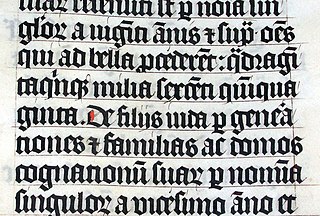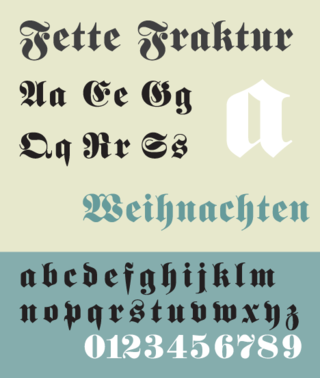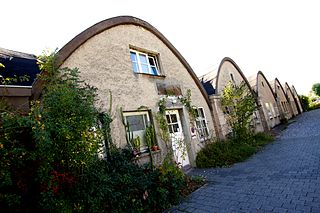Related Research Articles

Blackletter, also known as Gothic script, Gothic minuscule, or Textura, was a script used throughout Western Europe from approximately 1150 until the 17th century. It continued to be commonly used for the Danish, Norwegian, and Swedish languages until the 1870s, and for the German language until the 1940s, when Hitler's distaste for the supposedly "Jewish-influenced" script saw it officially discontinued in 1941. Fraktur is a notable script of this type, and sometimes the entire group of blackletter faces is incorrectly referred to as Fraktur. Blackletter is sometimes referred to as Old English, but it is not to be confused with the Old English language, which predates blackletter by many centuries and was written in the insular script or in Futhorc. Along with Italic type and Roman type, blackletter served as one of the major typefaces in the history of Western typography.

Antiqua is a style of typeface used to mimic styles of handwriting or calligraphy common during the 15th and 16th centuries. Letters are designed to flow and strokes connect together in a continuous fashion; in this way it is often contrasted with Fraktur-style typefaces where the individual strokes are broken apart. The two typefaces were used alongside each other in the germanophone world, with the Antiqua–Fraktur dispute often dividing along ideological or political lines. After the mid-20th century, Fraktur fell out of favor and Antiqua-based typefaces became the official standard.

Fette Fraktur is a blackletter typeface of the sub-classification Fraktur designed by the German punchcutter Johann Christian Bauer (1802–1867) in 1850. The C.E. Weber Foundry published a version in 1875, and the D Stempel AG foundry published the version shown at right in 1908.
Bauersche Gießerei was a German type foundry founded in 1837 by Johann Christian Bauer in Frankfurt am Main. Noted typeface designers, among them Lucian Bernhard, Konrad Friedrich Bauer, Walter Baum, Heinrich Jost, Imre Reiner, Friedrich Hermann Ernst Schneidler, Emil Rudolf Weiß, and Heinrich Wienyck, designed typefaces for the company.
Carl Winckow known in Spain, where he spent most of his working life, as Carlos Winkow was a German type designer who worked primarily for the Nacional Typefoundry.
Ludwig & Mayer was a German type foundry in Frankfurt am Main, Germany. Many important designers worked for the Ludwig and Mayer type foundry, including Heinrich Jost, Karlgeorg Hoefer, Helmut Matheis, and most notably Jakob Erbar, whose Erbar Book was one of the first geometric sans-serif typefaces, predating both Paul Renner's Futura and Rudolf Koch's Kabel by some five years. Starting in 1925, Ludwig & Mayer types were distributed in the United States by Continental Type Founders Association. When the foundry ceased operations in 1984, rights to the typefaces was transmitted to the Neufville Typefoundry.

D. Stempel AG was a German typographic foundry founded by David Stempel (1869–1927), in Frankfurt am Main, Germany. Many important font designers worked for the Stempel foundry, including Hans Bohn, Warren Chappell, F. H. Ehmcke, Friedrich Heinrichsen, Hanns Th. Hoyer, F. W. Kleukens, Erich Meyer, Hans Möhring, Hiero Rhode, Wilhelm Schwerdtner, Herbert Thannhaeuser, Martin Wilke, Rudolf Wolf, Victor Hammer, Hermann Zapf, and Gudrun Zapf von Hesse. With the introduction of Memphis in 1929, the foundry was the first to cast modern slab serif typefaces.
Johann Christian Bauer (1802–1867) was a German type designer, punchcutter, and founder of the Bauer Type Foundry. Bauer was born in Hanau and began working as a punch-cutter in 1827. He ran a type foundry in Frankfurt am Main, Germany for three years with Christian Nies, before founding the Bauersche Gießerei in 1837. From 1837 to 1847 he worked for the firm of P.A. Wilson in Edinburgh, where he could study punch-cutting and type founding, as Great Britain was at that time in the forefront of the industry. While still in Edinburgh, he founded the firm of Bauer, Furgusson et Huie, though upon his return to Germany in 1847 the foundry was renamed Englische Schriftschneiderei und Gravieranstalt . A prolific craftsman, Bauer cut more than 10,000 punches with his own hands, though few of his designs are in use today as they are typical of the excesses of pre-Arts and Crafts Movement nineteenth century design. By the end of his life, the Bauer foundry was a worldwide concern.
Georg Belwe was a German type designer, typographer, graphic artist and teacher.
The Ludwig Wagner Type Foundry was established in 1902 in Leipzig after the veteran punch cutter Ludwig Wagner took over the small foundry Gundelach & Ebersbach in 1901. The beginning of his modern type production and the extension of his business happened before 1914. The large manufacturing facilities in East Leipzig suffered extensive bomb damage during World War II. In 1949, the company was given new facilities in the Southwestern part of Leipzig. Ludwig Wagner AG was incorporated into Typoart by the East German government in 1960 and Wagner himself moved to the German Federal Republic.

J.G. Schelter & Giesecke was a German type foundry and manufacturer of printing presses started 1819 in Leipzig by punchcutter Johann Schelter and typefounder Christian Friedrich Giesecke (1793-1850). The foundry was nationalized in 1946 by the new German Democratic Republic, forming VEB Typoart, Dresden.
C.E. Weber was a German type foundry established in 1827 in Stuttgart. Noted designers working for the foundry included Georg Trump, and Ernst Schneidler. The foundry closed in 1970; some designs passed to the Johannes Wagner Type Foundry, others to Stempel.
Johannes Wagner, Inh. was a type foundry created in 1921 by Johannes Wagner with his brother and brother-in-law in Berlin, moving to Ingolstadt in 1956. In the early 1980s the firm acquired many of the matrices of the Weber Typefoundry and most of those from Berthold. The company, by then named Letternservice Ingolstadt, closed in 2002, and its printing assets were moved to the printing museum in Leipzig.
The Klingspor Type Foundry was a German hot metal type foundry established in 1892 when Carl Klingspor bought out the Rudhard’sche Foundry of Offenbach. His sons, Karl and younger brother Wilhelm, took on the business in 1904, renaming the foundry Gebrüder Klingspor in 1906, and turned it into a major concern. Famous type designers like Rudolf Koch, Walter Tiemann and Otto Eckmann worked for this foundry and created well known typefaces like Koch Antiqua, Wilhelm Klingspor, Tiemann Antiqua and Eckmann.

Haas Type Foundry was a Swiss manufacturer of foundry type. First the factory was located in Basel, in the 1920s they relocated to Münchenstein.
Schriftguss AG was a type foundry in Germany founded in 1892 under the name Brüder Butter by purchasing the type casting firm of Otto Ludwig Bechert that had been founded in 1889. It was later incorporated in 1922 as Schriftguss A.-G. vorm. [prev.] Brüder Butter. Their types were known for “vigour, liveliness and freshness.” Though some faces were done in house, the foundry mainly worked with outside “Schriftkünstler”, more than was typical at the time. A unique product of the foundry were modular systems of “Plakattype” to compose shapes and letterforms for display and jobbing applications, for instance Dekora, or Albert Auspurg’s 1931 Ne-Po (negative–positive), and finally Super-Plakattype in 1949. After the Nazi seizure of power in 1933 the last of the Butter brothers resigned from the corporation and it was changed to a limited partnership. In 1948 the company was expropriated by the post-war communist government and became public property, under the name VEB Schriftguss Dresden, eventually becoming merged into VEB Typoart – Drucktypen, Matrizen, Messinglinien in 1951. As a state run enterprise, the foundry lost its verve and panache and settled into producing serviceable type without distinction.
Genzsch & Heyse was a German type foundry established in Hamburg. In the 1920s and 1930s, G+H types were sold in the United States by Continental Type Founders Association.

Walbaum is the name given to serif typefaces in the "Didone" or modern style that are, or revive the work of early nineteenth-century punchcutter Justus Erich Walbaum, based in Goslar and then in Weimar.
Arnold Drescher was trained as a teacher in Auerbach in 1896 and later studied at Dresden Academy of Fine Arts from 1905 to 1907 where he became a specialised instructor for art teachers, becoming a professor in 1920. As well as working freelance as a designer, he was also employed by the Staatliche Akademie für graphische Künste und Buchgewerbe. Between 1940 and 1945, he was the Academy's director. As well as being a typographer, he was a prolific painter and illustrator, designing posters for the East German government. In 1960 he retired to Braunschweig where he later died.
Max Salzmann was a German designer at the Schelter & Giesecke Type Foundry. He immigrated to the United States.
References
- 1 2 3 "Johannes Anton Hiero Rhode". luc.devroye.org. School of Computer Science, McGill University, Montreal, Canada. Retrieved 25 May 2021.
- 1 2 3 "Rhode".
- ↑ Berry, William Turner (1962). The Encyclopaedia of Type Faces. Pitman Publishing Corporation.
- ↑ Journal of Scholarly Publishing. University of Toronto Press. October 1979.
- ↑ Jaspert, W. Pincus, W. Turner Berry and A.F. Johnson, The Encyclopedia of Type Faces. Blandford Press Lts.: 1953, 1983, ISBN 0-7137-1347-X, p. 114.